How Deep Should a Fence Post Be?
Publish on: 02-Feb-2025

When it comes to building a fence, one of the most crucial steps is setting the posts. How deep you bury your fence posts will determine how stable and long-lasting your fence is. Posts that aren't solidly seated can lead to a leaning, wobbly, or even collapsing fence over time. So, how deep should a fence post go? Let’s break it down.
General Rule: 1/3 Rule
The 1/3 rule is a good rule of thumb: one-third of the fence post should be below the ground, and two-thirds should be above the ground. So, if your fence is 6 feet tall, your post should be 9 feet long, with 3 feet buried in the ground. This ensures the post has enough support to stand straight and withstand wind, weather, and other forces.
Key Considerations Regarding Post Depth
Although the 1/3 rule is a useful guideline, the precise depth can depend on a lot of things:
- Fence Height: Higher fences require deeper posts. Maybe 2 feet deep for a 4-foot fence. You’ll need minimum three feet of depth for an 8-foot fence.
- Soil Type and Climate: Posts need to go deeper in soft or sandy soil for stability. Soil that is rocky or heavy with clay might not require digging as deep, but the firmness of the ground will help keep the post in place. If you live in an area with freezing winters, the post must be buried below the frost line to prevent the ground from pushing the post up as it freezes and thaws.
- Fence Material: Heavier materials like wood or vinyl require deeper posts for support. Lighter materials, such as chain-link, may not need as much depth.
Recommended Depths for Common Fence Types
Here’s a quick guide for how deep to bury posts based on the type of fence:
- Wooden Fences: For a 6-foot wooden fence, dig holes at least 2.5 to 3 feet deep. Wood is heavy and can catch wind, so deeper posts are essential.
- Chain-Link Fences: These are lighter, so 2 feet of depth is usually sufficient for a 6-foot fence.
- Vinyl Fences: Vinyl is lightweight but can be affected by wind. For a 6-foot vinyl fence, aim for 2.5 feet of depth.
- Decorative or Short Fences: For fences under 4 feet tall, 1.5 to 2 feet of depth is often enough.
Tips for Setting Fence Posts
- Use the Right Tools: A post-hole digger or auger will make digging easier and ensure the holes are the correct depth and width.
- Add Gravel for Drainage: Place a few inches of gravel at the bottom of the hole to prevent water from pooling around the post, which can cause rot.
- Use Concrete for Stability: Pour concrete into the hole to secure the post. Let it set for at least 24 hours before attaching the fence panels.
- Check for Level: Use a level to ensure the post is perfectly vertical before the concrete sets. Even a slight tilt can cause problems later.
Common Mistakes to Avoid
- Digging Too Shallow: Posts that aren’t buried deep enough will wobble or tip over.
- Ignoring the Frost Line: In colder climates, failing to dig below the frost line can lead to shifting posts.
- Skipping Concrete: While it’s possible to set posts without concrete, using it ensures maximum stability and longevity.
Conclusion
Making your fence post depth important for a strong and durable fence. Use the 1/3 rule as a general guideline, but use your knowledge of your fence height, soil type, and climate to adjust accordingly. Digging the proper depths with concrete and leveling don’t happen by accident, but your fence will thank you by standing for years.
Recent Posts
How Much Rebar Do I Need? – A Complete Guide
How Much Epoxy Do You Need for Your Floor?
How to Calculate Yards of Concrete: A Simple Guide for Your Next Project
Difference Between Cement and Concrete: What You Need to Know
How to Calculate Tile for a Shower: A Beginner’s Step-by-Step Guide
Roof Truss: Picking the Right Thickness for Your Project
Concrete Slab Construction: Materials, Process & Thickness Rules
How to Calculate Square Feet of a Wall: A Beginner’s Step-by-Step Guide
What is Crown Molding? Its Pros, Cons, and Uses
What is MDF? A Complete Guide to Medium-Density Fiberboard
What is Concrete? History, Types, Costs, and Tips for Working with It
What is Asphalt, How is it Made, and How Much Does it Cost?
Drywall: A Complete Guide to Installation, Repair, and Finishing
Floor Wax Guide: Best Practices for Wood, Tile, and Hardwood Surfaces
Tar and Gravel Roofs: A Durable Roofing Solution for Modern Homes
What Masonry Sand Is and Its Uses
Building and Installing Post and Rail Fences
Best Plywood Types for Roofing: Strength, Durability, and Protection
Slope: Why It Matters and How to Define It
Roof Panels: Types, Installation, Costs, and Maintenance
Electric Fences: Installation, Costs, Testing, and How They Work
How to Calculate Acreage of an Irregular Lot?
How Deep Should a Patio Base Be? Expert Tips and Material Choices
Deck Posts: Types, Materials, Pros & Cons, and Spacing
Types of Stone Wall: A Complete Guide
Mild Steel vs Carbon Steel | What is the differance?
5052 vs. 6061 Aluminum: Key Differences and Best Uses
Carpet Area vs Built-Up Area: What’s the Difference and How to Calculate?